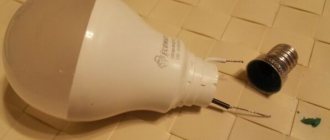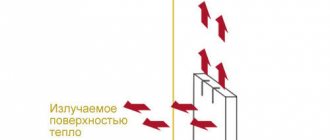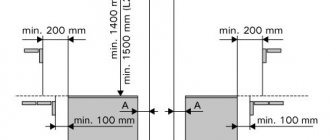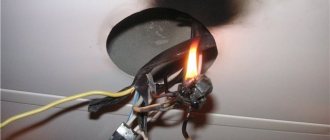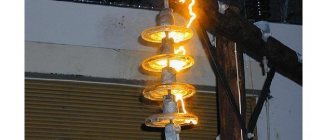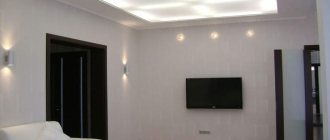Anyone who is sure that heated floors are a modern invention are very mistaken. This idea came to the minds of the ancient Romans, who successfully heated their thermal baths in this way - the ancient baths. Centuries have passed since those times, the design has undergone significant changes and new technologies have appeared.
Today, the user can choose from different options; the main difference between the systems is the type of coolant. To understand which heated floors are better - water or electric, you need to learn about the features of the design, installation and operation of heating systems.
The final decision on organizing underfloor heating is made based on the budget for the upcoming renovation, as well as the type of room and operating conditions. You will find answers to all of the above questions in our article.
Types of electric heated floors
Electric floors are divided into three types:
- infrared – heating function based on the principle of infrared radiation;
- thermomats - the room is heated by special thin cables (single/double-core);
- cable - heating occurs using cable sections.
Types of infrared structures:
- film;
- rod-shaped
Types of cable heating:
- design for thin floors;
- heat storage system;
- direct heating;
- construction under a wooden covering.
Films with infrared radiation
It’s worth choosing infrared floors if you want to get the optimal combination of high efficiency and fairly economical energy consumption. Just like heating mats, thermal film can be laid on any base and even on an old floor. Due to the small thickness of the product, the height of the room is not reduced.
Thermal films, due to uniform heating, have proven themselves when working with wooden coverings. Another advantage of infrared systems is their healing effect on the body. They are ideal for people with allergies because they do not carry dust particles due to the lack of convection.
Thermal films with infrared radiation provide a healing effect
Electric heated floor installation
Infrared film consists of two layers of polymer material, between which a carbon nanostructure (heating element) passes. The material emits infrared light, the wavelength is 5-20 microns.
The design contains carbon strips and copper bars. The width of the strip is 1.5 cm. Busbars coated with silver connect the strips and pass electric current.
On both sides, the heating element is protected by a special polymer, which protects against moisture, fire and does not block infrared light.
The infrared rod floor is manufactured in the form of numerous rods connected in parallel to each other using flexible connecting wires. Inside the rods there is a mixture of silver, carbon, and copper.
When an electric current hits carbon fiber, thermal energy is released.
Thermal mats are made using a thin cable attached to a fiberglass mesh. For protection, the heating core inside the cable is covered with a special screen, insulating material and an additional sheath.
The heating temperature is regulated using a thermostat. It is connected to the power supply network using a cold wire, the length of which is at least 2 m.
A special coupling is used to connect the heating and cold cables. The surface temperature is controlled using a thermostat and temperature sensors.
The cable floor is characterized by high efficiency levels - almost complete conversion of electric current into energy occurs.
The function of the heating element, regardless of the type of system, is performed by the cable. It is divided into two types:
- resistive;
- self-regulating.
Resistive cable can be single- or double-core. A single-core cable includes a metal core and an insulation layer. In a two-core cable, one core can perform the heating function, the second - power. It is possible to have two heating cores.
On the outside, the cable is protected by a metal braid and a screen. The amount of energy released by a self-regulating cable varies depending on the ambient temperature. Heating cable is supplied in reels, rolls and sections.
Heating includes thermostats that regulate temperature and temperature sensors designed to gain knowledge of environmental conditions for efficient operation.
Twin cable
Like the previous single-core option, the two-core cable can be laid in a screed or underlay. This type of cable has two separate conductors that are insulated from each other. Its design is as follows:
- Conductive conductors;
- Insulation;
- Reinforcing braids (separate for each core);
- Water-repellent screen;
- External insulation;
- Grounding.
Twin-core cables can have one or two grounding connections. The illustration shows an option with one - it is located outside the reinforcing braids. In the case of two, they are usually located inside the braids of each core.
When laying a two-core cable, there is no need to connect the other end to a power source. At one end of the cable, you need to connect the current-carrying wires together, and on the other side, connect them to the controller, network, etc. Laying is carried out according to the following scheme:
Method of laying and connecting a two-core cable heated electric floor.
Characteristics
The infrared floor kit consists of film, installation wires, contact clamps, bitumen insulation, documentation (installation manual, passport, warranty).
Technical characteristics of film infrared coating:
- length – 50 m;
- width – 0.5-1 m;
- thickness – 0.23-0.47 mm;
- temperature – 31°C;
- power consumption 1 m² – 25-35 W/h.
Technical characteristics of rod infrared coating:
- maximum length – 25 linear meters;
- width – 0.83 m;
- distance between rods – 0.10 m;
- temperature – 28-31°C;
- power consumption – 24 W/h.
The heating mat is supplied with a thin mat, equipped with a cable with a high-temperature insulating layer, a mechanical regulator with a temperature sensor, a corrugated tube, and documentation.
Technical characteristics of the thermomat:
- thickness – 4.5 mm;
- width – 45 cm;
- maximum heating element temperature – 90°C;
- power consumption 80-220 W/h.
The cable device kit includes a heating element, a temperature sensor, a thermostat, fasteners, documentation, including an installation diagram and instructions.
Technical characteristics of cable heated floors:
- maximum heating element temperature – 65°C;
- thickness – 7.5 mm;
- power consumption – 110–200 W/h.
pros
Infrared is energy efficient because it converts radiated energy into heat. The design is more economical compared to cable systems. The surface heats up within a few minutes.
In case of mechanical damage, only the failed segment of the structure loses its functionality. The remaining system continues to operate as usual. The room is heated evenly.
The coating is not subject to corrosion processes and is fire resistant. It is possible to use the film in rooms with increased load on the floor covering (in public places), and use the material as a wall heat source. Other benefits:
- Quick installation due to the absence of additional work. Installation takes no more than 1 day.
- Operation is possible immediately after installation.
- Installation of the structure on any floor covering without preliminary preparation and screeding of the base.
- Using a thermostat adjusts the temperature in the room.
- Heating the air using infrared radiation is not accompanied by a change in humidity levels.
- IR radiation does not harm the human body, but on the contrary, produces a healing effect.
The use of heating mats saves the height of the room, since installation requires no more than a few centimeters. The thermomat uses electrical energy economically. There is no need for installation under large household appliances or furniture.
The mats feature simple installation technology. Other benefits:
- Rapid heating of the floor covering due to its close location to the surface;
- Thickness (3-4 mm);
- Uniform heating of the room;
- No harmful radiation;
- Environmental safety of the materials used;
- Corrosion resistance.
The cable device is mounted directly into the screed, so it does not take up free space. During its service life, the structure does not require additional maintenance. Does not generate dust during operation.
The design does not use substances that cause allergic reactions. Other benefits:
- Involves setting and maintaining the required temperature conditions.
- Thanks to thermal sensors, the heated floor receives information about the environment and reacts to changes in it.
- Does not require the use of additional devices.
- It has a long service life, safety and reliability.
General benefits:
- Installation in public areas.
- Structural elements are not visible under the floor covering and do not affect the design of the room.
- The temperature regulator adjusts the automatic switching on and off of the heating.
- Used as the main or additional source of heating.
- Simple and quick installation that does not require special knowledge or equipment.
- Long service life.
- Uniform heating over the area.
- There is no need to install additional equipment to start.
Economical
Loud statements by system manufacturers about the cost-effectiveness of one or another option, which is superior to analogues, have no relation to reality.
In reality, in order to heat a room of a certain area, it is necessary to transfer, all other things being equal, the same amount of energy from any heating system. It does not matter which heater does this.
Accordingly, efficiency is determined only by correct preparatory work - if the heat insulator is correctly selected and installed, the efficiency of any heated floor approaches 95-96%.
We can talk about efficiency only if:
- Comparisons with other heating systems, such as radiators. In this case, any heated floors benefit.
- Using a water circuit with a gas boiler. In this option, heating costs will be significantly less than when using electrical equipment. However, the cost of the heater itself increases the cost of purchasing the system.
Minuses
The disadvantage of infrared coating is that it needs to be installed exclusively on a flat surface, otherwise the heating may not work correctly.
The kit comes with contacts - it is not always possible to connect the contact to the material the first time, so you have to cut the film and connect to another contact, which requires additional film costs.
If there is no gap of 2-3 cm between infrared heating and furniture or appliances, heating occurs, which leads to darkening of surfaces and overheating of individual sections of the film.
Heating mats as a heating source are used only in combination with those floor coverings that have a high level of heat conductivity. If mechanical faults occur, the system stops functioning.
It is forbidden to begin operation immediately after installation; the minimum period of time between installation and use is 2 days. If glue is used during the installation procedure, operation begins no earlier than a week later.
Thermal mats do not guarantee complete fire safety.
The cable device ensures uneven heating of the room. There is insufficient efficiency in heating the floor covering. The installation procedure is performed with a screed. Installation takes 3 days.
The choice of flooring suitable for cable construction is limited to tiles and granite. If damaged, the heating completely fails. Operation is permitted no less than 14 days after completion of the installation procedure.
The cable device does not guarantee full fire safety and is subject to corrosion processes.
General disadvantages:
- The need to install the structure only on free areas of the surface (without equipment and furniture) limits the thermal power.
- Furniture prevents the uniform passage of heat flow, so difficulties arise in using an electric floor as the main source of heating.
- The permissible temperature on the surface of the floor covering is 31°C. Heating of the room to a comfortable temperature of 20-22°C occurs over a long period of time.
- The thermostat, which is equipped with an electric heated floor, regulates the temperature of the heating elements, not the room.
- Electric heating is characterized by high operating costs associated with increased energy costs.
- In rooms with high humidity there is a risk of electric shock. In order to improve electrical safety, additional costs are required for RCD (residual current device) and grounding.
- Heating cable devices emit an electromagnetic field that is harmful to the human body.
- If the system is used as the main source of heat in large areas, powerful electrical wiring is required for correct operation.
How to choose an electric heated floor
If the purpose of the electrical structure is to maintain a comfortable floor temperature (not heating the room), and the floor covering is linoleum, parquet, carpet, laminate, then infrared film is a suitable option.
If heating is installed under the tiles, then in this case the use of film is not practical, since gypsum fiber sheets (GVL) are laid between it and the floor covering for the purpose of thermal insulation.
It is recommended to use heating mats under the tiles: the floor covering is laid directly onto the heating using tile adhesive immediately after installation. In this case, the lack of thermal insulation contributes to rapid heating of the surface and reduced energy consumption.
When choosing between cable technology and a mat, be guided by the possibility of raising the floor level in the room. The mat is laid directly under the covering, so the surface rises no more than 1.5 cm.
To install the cable, a 3-5 cm screed procedure is required. In the final form, taking into account the glue and tile flooring, the surface rises by no less than 4 cm.
Features of heating using an electrical system:
- To fully heat a room in which there are no other heat sources, an electric heated floor must occupy at least 70% of the room’s area.
- Only the space free from furniture and equipment is taken into account.
- If the room is too crowded with furniture, this heating system will be ineffective.
- To maintain a comfortable temperature in the room, the power density of the structure should be in the range of 150-180 W.
The functional element of the electrical system is the temperature controller. Thermostats are divided into two types:
- mechanical;
- electronic.
The mechanical device involves constant manual adjustment of turning the heating on and off and changing the temperature regime. An electronic thermostat requires you to enter parameters once, which are subsequently activated automatically.
You can set the desired temperature and program the device to turn on and off at specific times.
Criterias of choice:
- characteristics and features of the premises;
- use as a main or auxiliary heat source;
- technical specifications of electrical wiring;
- type of flooring;
- the need for “smart” management.
Necessity of coordination
In this regard, water systems are inferior to their electric “brothers”. The latter, regardless of type, can be installed without coordinating the project with regulatory authorities. The exception is the situation when the power turns out to be greater than the in-house power supply networks can provide. In this case, they will need to be modernized, which is carried out by the supplier company.
Installation of a water heated floor requires approval in any case, except for installation in a private house. Moreover, only an autonomous system has a chance to obtain permission. Powering it from centralized heating mains is prohibited in most regions and settlements.
Which is better
When choosing an electric heated floor, pay attention to the package contents, installation instructions, and technical data sheet. The documents indicate all the characteristics of the device, including power, length, operating voltage.
The kit must contain fastening elements with which the cable, film or mat is installed. It is better to immediately discard material in damaged packaging or with obvious defects.
An effective and high-quality device for heating the floor surface works with a thermostat that maintains the required temperature and saves energy.
It is recommended to give preference to fireproof, rust-resistant, environmentally friendly materials without harmful radiation. Warm floors should not affect the humidity level in the room.
If you plan to install heated floors in your home, the material must be suitable for various types of floor coverings. An effective system quickly warms the floor surface to the required temperature.
If the structure occupies the entire area of the room (used for full heating), it should evenly increase the temperature in the room.
Price
The cost depends on the choice of components and is approximately the same
Currently, there is a situation in which it is difficult to give preference to water or electrical systems. The use of high-quality materials and components has made the cost of heated floors of all types approximately the same - within the range of 11-15 US dollars per 1 sq.m. heated room (including installation by specialists).
Expert opinion
Chebatkov Maxim Pavlovich
Specialist in household appliances and their repair
You can save money by purchasing equipment and materials from little-known companies, but the quality in this case is not guaranteed. Only the rod floor stands out from the overall picture - the new product will cost 35-40% more than its well-known analogues.
Thus, when choosing and having the opportunity, it is worth giving preference to the water-based “warm floor” system, which is slightly superior to its electric counterparts in terms of the sum of indicators. The arguments against this are complexity and, most importantly, mandatory approval from supervisory authorities (the latter is not relevant for installation in a private home).
Exploitation
If infrared thermal film is used as the main source of heating, it should occupy at least 70% of the floor surface. It is not recommended to use it for heating in difficult climatic conditions.
In this case, the infrared film coating serves only as an additional source of heat. The thermal film is cut only in a specially indicated place - this is taken into account when calculating the amount of material.
Infrared heating is also applicable for commercial buildings that cannot be equipped with central heating. The use of thermal film at sub-zero temperatures prevents freezing and icing of the porch and pipeline.
Thermomats are used to heat floors for a short period of time. The use of mats is advisable if there are no plans to increase the current floor level (thick screed).
Thermal mats are mounted in a layer of tile adhesive, the thickness of which does not exceed 3-5 mm.
Cable underfloor heating is used as the main source of heat in rooms where central heating is difficult to install. In most cases, the system is equipped in rooms located on the first floors of buildings, bathrooms, corridors, and toilets.
The coating is mounted directly on the reinforcing mesh or heat-insulating layer. It is possible to use cable flooring for outdoor heating:
- warming up the lawn, heating the soil in greenhouses;
- in order to eliminate icing of gutters, drains, roofs, pipelines;
- for heating stairs, driveways, sidewalks.
Installation:
- The direct action system heats the surface over a short period of time. Installation is carried out for the purpose of full heating or heating of individual rooms.
- The storage cable device is economical due to heat accumulation.
- When installing a cable system under a wooden floor covering, the free space is filled with a heat-insulating layer, and the cable is placed on a metal mesh.
Precautionary measures:
- To ensure the required level of heating, the power and type of power cable are carefully selected, and thermal insulation is organized according to the instructions.
- Do not lay the cable under furniture without legs or large household appliances to avoid overheating.
- Shortening the cable negatively affects the strength, so select the parameters of the heating elements in accordance with the size of the room.
- During the installation process, do not wear heavy shoes or step on the cable.
- Draw up an installation diagram - it will be needed if the heating elements are damaged.
- A corrugated tube is used to connect the temperature sensor.
- Upon completion of installation of the electric heated floor, check all connections, measuring the resistance level.
- The system is connected only after the screed has completely dried.
Guarantee
The warranty period for heated floors depends on the type:
- infrared film – 15 years;
- infrared rod – 20 years;
- thermomats – 20 years;
- cable - 20 years.
The warranty is valid if the cause of failure of a specific segment of the structure or the entire system was an initial malfunction - a manufacturing defect.
The warranty is valid in case of malfunction of the heated floor during operation, with the exception of the following cases:
- The material has traces of mechanical damage as a result of violation of the conditions of transportation, installation, and storage.
- The cause of burnout was a mechanical or chemical effect on the material.
- The heat source was used without the use of a thermostat.
- The system was not used for its intended purpose.
- The heating elements failed due to a domestic accident (flooding with water, voltage drop).
- The installation and use rules described in the instructions for the heated floor were violated.
- The heating was connected to the power supply in violation of the rules specified in the documentation (the current strength and voltage in the network were higher than in the instructions for the heated floor).
- The electrical structure was installed near sources of high temperature.
- Failure is caused by irresistible natural and man-made phenomena (lightning strike, fire).
Subject to compliance with the warranty conditions, the manufacturing company replaces the failed section or system, depending on the type of heated floor. The company does not bear the costs associated with the delivery of the material.
For replacement in accordance with the terms of the warranty, a list of documents is provided:
- a completed warranty card (original);
- a document confirming the purchase of material with a specified date (otherwise, the calculation of the warranty period will begin from the date of completion of production);
- photographs certifying the operation of the heated floor in accordance with the requirements specified in the instructions;
- In the absence of photographs, it is possible to call specialists who will attest to the fulfillment of these requirements.
FAQ
How expensive are electric heated floors?
Contrary to popular belief, their electricity consumption is not too high. It can be compared to the consumption of an oil cooler. At the same time, the operating mode of the heated floor is selected based on weather and climatic conditions, which allows you to save on heating on warm days.
There is information that infrared systems create strong electromagnetic radiation. How dangerous is it?
This issue has been thoroughly researched and tested many times. Radiation from a heated floor is 20 times lower than the sanitary standard. For example, the radiation from a TV is much higher, so there is nothing to worry about.
Is it possible to change the length of the heating cable?
No, you can't do this. The cable is cut into sections of a certain length, designed to connect to the network and create a given load. If the cable is shortened, the wiring will be at risk of overheating. In addition, the RCD may trip and energy consumption will become too high.
How long do heated floors last?
If these are products from well-known companies, only the warranty period can range from 15 to 50 years. Of course, you can count on such durability only if you follow the installation technology and rules of use.
Is it necessary to install a thermostat?
Yes, this is required. Otherwise, you will have to endure the heat or freeze with the heating system running. Installing a thermostat will not only allow you to adjust the heating mode, but will also make it possible to save on energy consumption on warm days.
Malfunctions and repairs
In electric heated floors, malfunctions are associated with three problematic parts:
- Temperature regulator;
- temperature sensor;
- a heating element.
Structural repair begins with identifying the source of the problem. In the case of preliminary repair work, the cause is usually failure of the heating element due to the use of construction tools.
If the causes of the failure are initially unknown, you need to measure the supply voltage. These parameters are indicated in the technical data sheet. The maximum deviation from the data specified in the passport should not exceed 5%.
When checking the temperature sensor, the readings should be within 5-30 kOhm (the exact parameters are indicated in the instructions).
If the cause of the malfunction is a temperature sensor or thermostat, the unsuitable part is replaced. Failure of the heating element requires dismantling the floor covering, opening the screed, and repairing damaged sections of the cable.
Installation procedure
Let's consider laying an electric heated floor without a screed. This is an option that works for most varieties.
Procedure:
- Complete subfloor cleaning. Remove the old flooring and plank flooring (you don’t have to remove it, but the floor level will be changed). Inspect the surface, remove all fasteners and other parts.
- Seal cracks and potholes in the subfloor.
- Lay a layer of thermal insulation. You can cover the room with penoplex, or use ready-made mats for heated floors. They are needed only for the heating cable; all rolled varieties are placed on an even layer of heat insulation.
- Lay the fiberglass mesh, fixing it to the insulation with double-sided tape.
- The heating cable is laid according to a pre-selected pattern.
- Connect the cable and temperature sensor to the control unit installed on the wall in close proximity to the heating element (this allows you to reduce the resistance of the wire).
- Apply power and check system operation. If there are no complaints, sheet materials (plywood, chipboard or OSB) are laid.
- Laying the floor covering.
The general scheme of work is presented. There may be additional procedures that have to be performed in rooms with complex configurations or problems with the subfloor.



